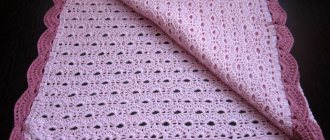You need to hold a newborn in your arms more often; this makes them feel confident and safe. If you are walking, feeding him or washing him, then the question arises, how to properly pick up a newborn baby?
Each mother has only two hands; you need to hold the baby in such a way that it is comfortable for him, and it is convenient for you to hold him or other objects, control the process of feeding or washing. The fear of “damaging” the baby is unfounded, they are not so fragile, but there is really no need to drop it.
Now let's look at this in more detail.
The need for tactile contact
Discussions continue on the topic of how much time a child should spend in the arms of his family. Of course, you shouldn’t take your baby at his first request, but you also shouldn’t reduce tactile contact to a minimum. The famous pediatrician E. O. Komarovsky warns about the danger of raising a little manipulator if you teach a baby to constantly be held in your arms. But he also talks about the importance of interaction: “Nature itself has programmed the human child in such a way that for its full development it requires constant visual, sound and tactile contact with the adults around it.”* Close contact with the mother and other relatives gives the child a sense of security, warmth, love. As it grows, it also allows the newborn to get acquainted with the world around him and promotes the harmonious development of the baby.
Why do you need to pick up your baby?
Lately, you can increasingly hear that you need to try to hold a child in your arms as little as possible, to teach him to be independent from the cradle. Some parents say that the consequence of such wearing is that the baby constantly asks to be held, even when he becomes older and can move independently.
However, there are also mothers who believe that it is simply necessary to carry a baby in your arms and do this as often as possible. They argue that this behavior is beneficial for the child’s body for a number of reasons:
- When a mother carries a toddler in her arms, she has a beneficial effect on the physical development of her child.
- Little children absolutely need to feel their mother’s love; intimate contact with her is very important for them.
- When a baby is carried in his arms, he has the opportunity to examine everything that surrounds him. This is also necessary for understanding the world and for the intellectual development of the baby.
How to lift your baby out of the crib
To take a baby, you need:
- wash your hands, since the newborn’s immune system is still weak, and there may be bacteria on his hands that are dangerous to his health;
- free yourself from other things; it is especially dangerous to hold a child and at the same time try to carry something from place to place;
- calm down, because young children sense the mood of adults very well and react to it;
- move calmly, smoothly, confidently;
- lean over the crib, giving the child the opportunity to see his face;
- put your palm under the head, neck and shoulder;
- use the second palm to fix the back and butt;
- gently lift the baby.
The child is lowered back into the crib in the same position, smoothly bending with the whole body. The palms are not removed for a few seconds, allowing the baby to get used to the new position. Making sure that he is not scared, the palms are carefully removed.
Place the child on a horizontal surface
- When you place your baby on a horizontal surface, such as a bed or changing table, remember that you need to lay him down in the same way as you lift him, that is, gently holding him by the head and butt. In this case, you need to lower not only your hands, but also bend over with your whole body, then it will be easier for you to put the baby down as carefully as possible.
- It is important for the baby to sometimes lie on a hard horizontal surface, this trains the abdominal and back muscles. Also, some pediatricians advise placing the toddler on his tummy before feeding. This is important for his digestive and excretory systems. Firstly, this position helps remove excess gases from the intestines, which relieves the baby from colic. Secondly, the abdominal muscles are trained, which are also responsible for the removal of gases and bowel movements.
- You need to put the baby on your stomach for a short time. For the first time, a minute will be enough, then you can gradually increase the time of lying on your stomach.
- To harden babies, pediatricians recommend completely undressing them before placing them on a hard surface. Of course, you need to take into account the temperature in the room and the baby’s current health condition.
General recommendations
Below are some basic tips for holding your newborn.
- Monitor your child's behavior. If he cries or gets anxious, try changing positions.
- Support your baby's head and neck. He will begin to hold it confidently at about three months, but before that he needs constant insurance. To train and strengthen the cervical vertebrae, pediatricians recommend placing the baby on his tummy from the first days of life, starting from a few minutes.
- “Do not create a vertical load on a child’s fragile spine. Whenever you pick up a child in your arms, carry him, play, or sit him on your lap, be sure to support the baby under your arms or hold him close to you...”1.
- Make sure that the baby's nose and mouth are free to breathe, give him the opportunity to turn his head.
- Avoid putting pressure on the soft fontanelles on the newborn's head.
Poses in different situations
It is necessary to figure out how to use the above positions during feeding, bathing, walking, and other manipulations.
- When feeding . The most comfortable position is “cradle”. First, the mother must release the breast, and then take the baby in her arms. If your baby is bottle-fed, then this position can also be used. In this case, it is more convenient to take the bottle in the hand that supports the head.
- After feeding . After feeding, the baby must be held upright so that he burps the air that he swallowed while sucking the breast. A columnar or “Buddha” pose is suitable for this. A vertical posture is harmful, but 10-15 min. won't do much damage.
- When swimming . To bathe, you need to put your baby in the water and keep your head elevated. You lift it with one hand and wash it with the other. The position resembles a “cradle” or “tummy position”, with the difference that you only hold the baby by the head. Find out how to organize your newborn's first bath here.
- When washing . The main difference from bathing is that when washing the child, the child is not immersed in water. The most comfortable pose will be “Buddha”. You can wash your baby with the hand you hold your feet with.
There is no need to be afraid of curvature of the spine when bathing, since the buoyant force of water reduces the effect of gravity, the child feels lighter.
Hygiene procedures
Newborn babies need daily bathing and frequent washing to protect their delicate sensitive skin from irritation. If in the first days the baby may be wary when lowered into the water, then later he will look forward to swimming with pleasure. It is better to bathe a child together, when one person supports the baby’s head with both hands, and the second person washes the baby. When bathing alone, one hand is placed under the back of the newborn's head so that the palm supports the far shoulder and the head rests on the hand. Special devices for baths - mats, slides and others - greatly facilitate the bathing process. To wash the baby, place it along the mother’s hand, tummy up, with the butt lying on the palm. This makes it possible to wash the perineum from top to bottom, to the butt. This is especially important for girls, as it prevents infection from entering the genitals. Grown-up children can be laid face down, held along the chest and tummy, with the thigh in the palm of the hand.
How to comfortably hold a baby while bathing
To lower your baby into the tub or tub, you need to place your hand behind his back and shoulders and hold his bottom with the other. When the baby is already in the water, you can remove your second hand and wash the baby with it, and with the other try, in addition to the upper part of the body, to also hold the lower part.
The main thing is that the newborn’s head and chin are above the water during such procedures. All this should be done calmly and carefully.
- share with your friends!
Basic positions of a child in arms
It is important!
A newborn baby is not able to hold the head, the fragile spine is not able to fix the back, and children's joints and ligaments are very vulnerable. Therefore, when carried in your arms, it is necessary to provide support for your head, back and butt. The movements of adults should be smooth and careful, without jerking. It is harmful for a baby to remain in one position for a long time; this can lead to numbness in the arms and legs and even to the development of torticollis.
Therefore, during the day you need to periodically change the child’s position. Below are descriptions and photos of the most comfortable positions for a newborn baby.
General rules
In newborns, the bones are plastic, this is necessary for rapid growth and development of the musculoskeletal system. The muscles are not developed; a one-month-old baby is not even able to hold his head up on his own.
In the early stages of development, frequent and incorrect body position in sleep or in the arms of parents can lead to unnatural development of bones, posture, and joints. Therefore, the basic rules for carrying on hands are associated with a weak skeletal and muscular system:
- You need to gently support him by the back of his head until the newborn learns to hold his head up on his own. If the head hangs down, this will affect the improper formation of the cervical spine. Usually at 3 months they are able to lift and hold their head.
- A vertical or sitting position is also harmful for toddlers. It is not recommended to hold babies upright until they can sit up on their own. Until the age of six months, holding a baby by supporting his butt is not recommended.
- You cannot lift the baby by the arms. The glenohumeral joint is supported solely by muscles. If you regularly lift a toddler by the arms, this will lead to dislocation of the scapula, this will happen due to weak trapezius muscles.
- Holding your newborn tightly to yourself is also not recommended. The toddler's muscles are weak; he will not only be able to breathe, but will not even be able to push an adult away from him.
It is not recommended to hold the baby with one hand; it is not reliable; if you move carelessly, you can drop the baby and injure him.
Column
“After feeding, it always makes sense to hold the baby in an upright position (“column”) for 5-15 minutes,” advises Dr. Komarovsky. The baby leans his face against his mother, so that his head rests on his mother’s shoulder. It is held securely but gently with both hands in the lumbar and neck area and lightly patted on the back. This allows the air trapped during sucking to be burped, which reduces gas production and reduces the likelihood of regurgitation. As the child grows up, this position will give him the opportunity to view the world around him.
What not to do?
It is worth mentioning separately some mistakes that can lead to injury or improper development of the spine:
- if you hold a child in weight only by the arms, this will lead to injury to the ligaments in the area of the shoulder blade;
- do not hold the baby by the back of the head (up to 3 months);
- allowing the legs to hang down when you hold the baby in your arms, this will affect the development of the hip joints;
- sitting him down, holding him in an upright position, this will lead to curvature of the spine;
- pressing him too tightly;
- not control his movements when you hold him in your arms, get distracted;
- hold the toddler with one hand.
Visual instructions on how to pick up a baby and hold him in your arms in this video:
It is not advisable to keep babies in an upright position. But sometimes it is necessary so that the gases come out of the stomach, and the little one does not suffer from colic after feeding. There are 4 classic positions for a newborn: upright, Buddha, tummy and cradle. Take the child carefully, without jerking, control the position of the body, and be careful not to drop the baby.
Buddha pose
In this position, the baby really resembles a sitting eastern saint. It can be practiced no earlier than a month. The baby's head and back are pressed against the adult. One hand clasps the baby's chest, and the other supports the legs. In this case, stress should be avoided in the pelvic area. This position of the hips is a prevention of the development of hip dysplasia.
How to hold a baby in your arms correctly: instructions with photos
It is necessary to alternate poses, this will give the baby a versatile workout, and his muscles will not be overstrained.
Cradle
Traditional way to hold a child. The little one is in a horizontal position, slightly bent. His head rests on the elbow joint, with the same hand the adult supports his back and butt.
With your other hand you need to hold the toddler’s legs and butt. It turns out that the newborn is slightly turned to face the parent. If you often hold your baby this way, it is recommended to alternate hands so that the baby’s spine forms correctly.
Column
The position is vertical, so it is not recommended to carry the child like this for more than 10-15 minutes a day. However, the position is necessary after feeding, since it is in this position that the little one burps the air that he swallowed along with the milk.
We hold the baby facing us, his head rests on the adult’s collarbone, we support him by the butt with one hand, and the back with the other. By leaning back slightly, you will ease the load on your toddler's spinal column.
If you do not carry the baby in a column after feeding, then he will be bothered by gases and colic, which cause a lot of inconvenience; toddlers often cry due to colic and sleep restlessly.
On the tummy
“Flight” in the arms of the parents. We hold his chest with one hand and place his elbow so that the baby’s head can rest on it. We pass the other hand between the legs and rest the palm on the tummy. By the way, the pose develops the child’s neck muscles, which is why he begins to hold his head up faster.
The holding method is suitable for the prevention of colic, since if the toddler’s chest is slightly raised, the gases from the abdomen also leave faster.
Buddha pose
It is similar to the “Lotus” position, when the baby’s legs are pressed to the butt. The back and head rest on the adult’s chest. With one hand you support the toddler by the chest, with the other you hold the feet, pressing them to the butt. Despite the apparent “verticality”, the position is quite natural for babies; the spinal column does not experience heavy loads.
Rule No. 1: Do not lean towards the child with straight legs, but squat with your knees bent
Often we see how a mother, in order to lower herself to the height of the child and take him, bends her back, becoming like a question mark. At the same time, the legs remain straight, and the entire load when lifting the child will go to the lumbar spine. It is not right.
That's right - put your feet shoulder-width apart, squat down with your knees bent, take the child, and, straightening your legs, lift him up. At the same time, the entire load will go to the muscles of the legs and buttocks, which is very useful.
How to hold a newborn correctly: a guide for parents
The body of a newborn has a sufficient margin of safety to withstand the stress of childbirth, but sometimes parents subject it to tests for which it is not ready.
Source: Fotolia
Some parents take the baby in their arms with unimaginable precautions, while others, on the contrary, snatch him out of the crib as dashingly as if they were practicing techniques for detaining terrorists - by the arm or the leg (and sometimes both at once) and, well, tossing or shaking: they play This is how dads usually do things with a child. For mothers, it’s different: they are driven to despair by the baby’s cry, which in babies up to three months intensifies at night due to colic, which is common at this age. A woman who has lost control of herself as a result of chronic lack of sleep begins to shake her irrepressible child too intensely: “Will you ever shut up?!”
Newborn photo session: what we pay the photographer for. Frankly from a mother of three
What do the statistics say?
In the USA, 2,000 infants die annually from shaken baby syndrome, and in England - 100. On average, 27 such cases are recorded worldwide per 100 thousand children under one year of age.
Most often, infants are injured by shaking by fathers or stepfathers (68–83%), nannies (8–17%) and mothers (9–13%). Even slightly shaking a baby can lead to such damage to his brain that 10–20% of affected infants die, and 75% receive brain injuries with unpredictable consequences that reduce the quality of life.
Source: Fotolia
In the arms of Godzilla
Now compare your size and strength capabilities with the parameters of the baby and imagine for a minute that an angry Godzilla is performing the same trick on you. What kind of damage will you get away with as a result? Surely they are serious! After such a shock, the child also gets the full treatment, even going to the hospital. “Shaken Baby Syndrome” - there is such a diagnosis!
We'll talk about possible physical damage later, but think about psychological damage as well. The baby's tummy hurts a lot due to gases pushing through the intestines. In children under one year old, the myelination of nerve fibers has not yet completed: they are like metal wires without an insulating coating (myelin), so the pain impulse does not travel along exactly one “wiring”, but freely jumps to neighboring ones. Pain sensations become generalized: they reach such strength that it is difficult for an adult to imagine. That’s why the baby screams like crazy all night long!
4 reasons why discharge from the maternity hospital may be delayed
And what does the closest person do in this situation - the mother, who is supposed to protect from all troubles, next to whom any pain subsides? Instead of massaging the tummy clockwise, applying a warm (ironed with a hot iron) diaper to it, he grabs the little man and begins to shake him, greatly increasing the pain and almost causing injury! The colic period will end at three months, and the subconscious feeling of danger emanating from the mother will remain with the child for life.
“My eldest cried a lot in the first months,” one mother shares her experience on a parenting forum, “I didn’t get enough sleep, and I was very upset that my husband, who wasn’t working at the time, didn’t get up to calm the baby down and give me a break. I rocked the crib (it was on skids - like a cradle), and the rage grew in me, so my movements became more and more strong and sharp. I practically threw the unfortunate cradle against the wall to make as much noise as possible and wake up my husband. The child was shaking as if on potholes, he flew up in the crib and screamed louder. Now I’m scared to remember this: I could have harmed my son, I didn’t think anything of it from resentment and fatigue.”
Source: Fotolia
How to properly pick up a baby...from the supine position
With both hands, clasp his chest - your thumbs in front, and the rest holding his back. If the baby does not yet know how to hold his head up, create a support for it using your index fingers or your index and middle fingers together. Gently lift your baby up. ...from the “lying on your stomach” position Take it in approximately the same way, only now your thumbs will be located on your back, and the rest will be under your chest. If necessary, you can use your index, middle and ring fingers to support the child's head under the chin.
When do babies start holding their heads up?
Take care of your head
The baby's brain is primarily affected by shaking and tossing The cerebrospinal fluid, which circulates under the membranes of the brain and in its ventricles after such shock tremors as the ocean during an earthquake, boils like a tsunami: and all this is inside the baby’s head! Violation of liquorodynamics is a serious condition; it is manifested by headache, nausea, vomiting, an excessive increase in head circumference (a sign of developing hydrocephalus) and other unpleasant symptoms. The headache can also intensify directly from the concussion that we give the child at such moments.
Source: Burda Media
5 important principles 1. Don’t be afraid of the child: unjustified over-caution leads to stiffness and clumsiness in an adult’s movements and, as a result, to childhood injuries. 2. Do not make sudden movements when picking up your baby. 3. Never pick it up with one hand - only with both. 4. Do not lift or lower the baby quickly or rapidly. 5. Do not remove him from the crib by pulling him by the handles. The baby’s joint-ligamentous apparatus is still very weak and may not withstand such loads.
It is unacceptable to pull a child out of a stroller or playpen by the hands and forearms: for such treatment he can pay with a subluxation of the head of the radial bone. If you take the baby in a different way, pulling him by the shoulders (holding him between the elbow and shoulder joints), there is no danger of subluxation, but it is better not to do this either. Look at the baby’s face at this moment - he has the expression of a “hare” awakened on the bus by the controller: stunned and frightened, his head thrown back. No need to scare him like that!
Psychologist reveals the secret of how to involve your husband in caring for your baby
The younger the baby, the more the brain suffers: the newborn does not know how to hold his head, and it dangles from side to side when shaken and tossed, as a result of which the traumatic effect increases many times over. Even hemorrhages under the membranes of the brain are possible without external signs of damage: they are detected only during neurosonography of the brain - ultrasound examination through the large fontanel.
Typically, such hemorrhages occur during childbirth, but here loving parents, unaware of the danger, inflict stress comparable to that of labor on the child. According to scientists, the load from such free handling of a baby is similar in strength and consequences for the baby to injuries received in an accident when being hit by a car from behind. What if you shake and toss the child not too hard, but just lightly? Still, you shouldn’t do this: after all, shaken baby syndrome does not necessarily arise due to rough handling.
The negative consequences of such manipulations with infants were first described by neurosurgeons in 1971, and in 2003 the first congress on Shaken Baby Syndrome was held in Edinburgh. At the same time, the first trial took place in Switzerland, in which parents who threw a child during play were accused of causing harm to him through negligence. Alas, the majority of infants affected by strong shaking continue to have persistent neurological disorders, and every fourth of them dies. Such a sad statistic!
Source: Fotolia
Harmful advice Some bloggers in white coats add fuel to the fire by convincing parents that a newborn is not so fragile. And he withstands most manipulations calmly, including the so-called baby yoga, when immediately after birth, “spiritual” midwives tie the baby’s arms and legs almost in a knot.
They say that nature prepared the child for shaking and jumping. And they even advise transporting it upside down, holding it by the legs. If you take the baby by the legs and lift him up, the blood will rush into the vessels of the head, overflowing them and creating the threat of hemorrhages. What if the newborn starts to squirm, slips out of your hands and falls as he was hanging - upside down?
Hypertonicity and hypotonicity in a child: normal or pathological?
Both kidneys and heart
Everyone has heard about a concussion, but do you know anything about a kidney concussion? This is rare in adults - their kidneys are securely fixed in place. But for a baby everything is different! The connective tissue that holds the kidneys in a stationary position is still very thin, fragile, and stretchable. And the kidneys themselves are suspended too low - and are not protected by the ribs and muscles, which should serve as an additional guarantee against concussions. The right kidney is usually located below the left. If you handle the child carelessly, you can cause not only a concussion to the right kidney, but also real injury.
Source: Fotolia
Are your hands reaching out to shake the little screamer properly? Remind yourself of the consequences
Same thing with the liver! In infants it is larger than in adults, so about a third of it is not protected by ribs. And a child's heart! By bouncing your baby, you force blood to flow backwards inside the chambers of the heart and the large vessels surrounding it. Is it worth talking about how dangerous this is? We are talking about the heart, the development of which, like the entire cardiovascular system, is not yet complete!
What is the result? To suspect that a constant or one-time random “shock” was not in vain for a child, a set of symptoms that suddenly appeared in him will help:
* drowsiness; * convulsions; * decreased muscle tone (up to paralysis); * blindness; * deterioration of appetite; * breathing disorders; * loss of consciousness; * vomit; * headache; * excitability; * hydrocephalus with rapid increase in head circumference.
Why does a newborn baby constantly cry and how to calm him down?
5 ways to hold a newborn in your arms
Yes, there is no need to be afraid to touch your baby. But it is better to pick him up carefully, without haste or sudden movements. All of these methods are based on the age-related characteristics of the musculoskeletal system, the baby’s psyche and take into account the increase in his weight and the load on the musculoskeletal system of the parents.
Source: GettyImages
WEIGHT CONVENIENT Convenient for babies up to 3 months of age, when head support is a must. Support the baby's neck and back of the head with one hand, and the buttocks with the other, while his torso may be slightly bent and his face turned towards yours. This situation creates all the conditions for the baby’s much-needed emotional contact with his mother. Do not forget: in order for the child’s development to be harmonious and symmetrical, hands must be periodically changed, supporting the head with either the left or the right. IN THE HAND Ideal for babies 3–6 months old, although you can hold your baby this way almost from birth. He rests the back of his head on the shoulder of your hand, with the fingers of which you squeeze his feet, and with your forearm you fix the arms. With your other hand you support him under his buttocks. The child's legs are bent at the knees and hip joints and spread apart. Be sure to alternate hands from time to time! VERSATILE Hold your baby under your chest with the palm of your right hand and press his back tightly against your chest. With your left hand, grab the child's right thigh, bending his legs at the hip joints. Please note: the weight of a child under 6 months should not rest on your hand supporting the baby’s pelvis - this is harmful to his spine and may spoil his posture in the future. IN FRONT OF THE BELLY For children from 7 months of age, this method allows them to reproduce the same movements as when crawling on their bellies. It is this important motor skill that children should master at this age. Place your baby under your chest with one hand and pass the other between your legs, gently supporting your belly. The baby in this position can calmly move his arms and legs, training his muscles and coordination. Don't forget to change hands! ON THE SIDE Suitable for babies from 10 months, when they are already sitting confidently. Take your child so that he tightly wraps his legs around your side, while his back rests on your forearm. Support your baby's knee with your hand. One of the baby's hands is on your chest, the other is free. It is necessary to carry the baby alternately from one side to the other.
Consultant - Denis Kovalev, Doctor of Medical Sciences, Professor
Daily handling of the baby (handling)
- Helps the child better adapt to gravity
- Ensures the safety of the child
- Promotes motor development: training balance, strength, endurance, coordination
- Strengthens vital functions: breathing, intestinal motility, brain function through adequate stimuli
- Helps to gain bodily, emotional and cognitive experience
- Involves touch and restraint, which promotes sensorimotor development
- Gives the joy of movement
- May relieve stomach pain, anxiety and stress










